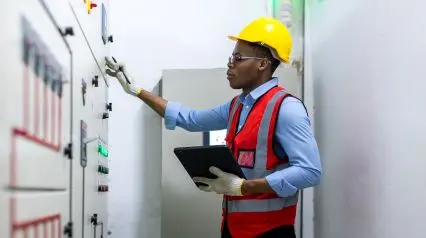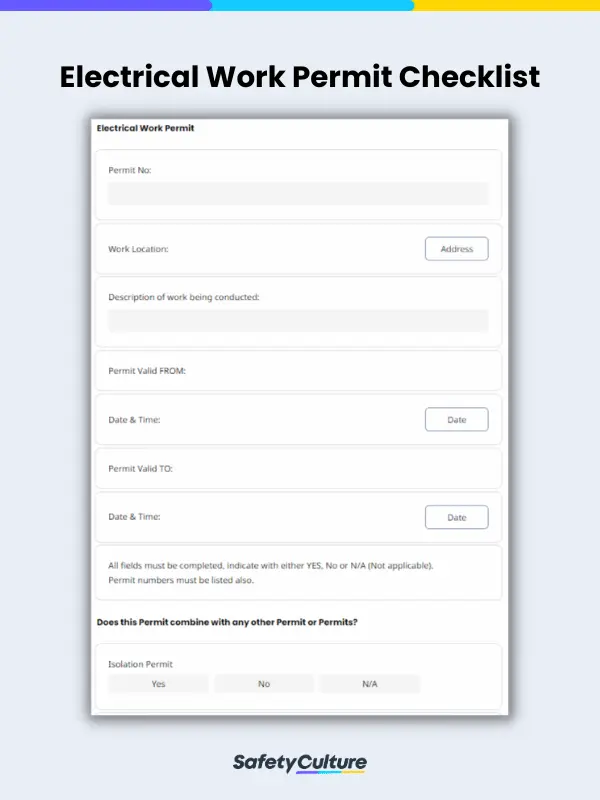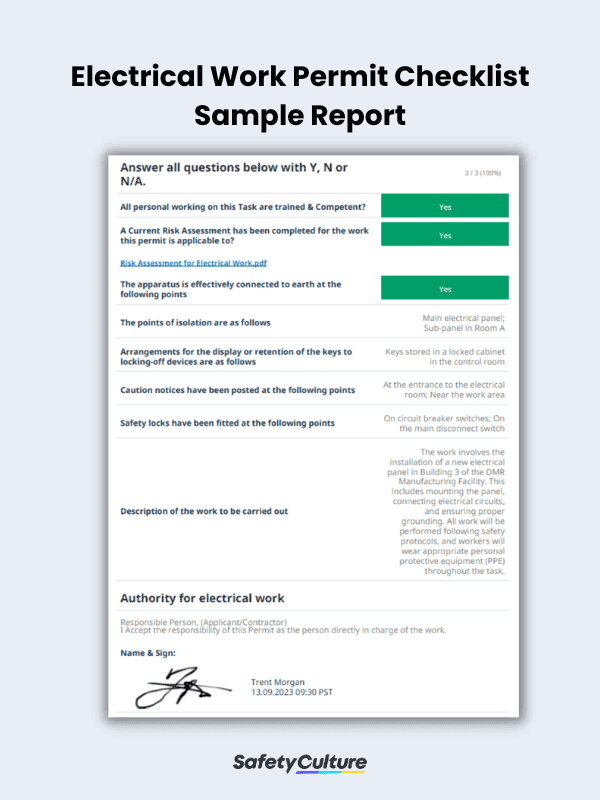What is an Electrical Work Permit Checklist?
An electrical work permit checklist is a tool used to ensure that safety measures, training requirements, and other permit details are complete and accurate to help those doing electrical work create a comprehensive work permit. This checklist typically consists of a series of questions and guidelines that must be reviewed, answered, and adhered to by electricians, electrical supervisors, and contractors before, during, and after electrical work takes place.
When is an Electrical Work Permit Required?
The exact requirements for electrical work permits can vary depending on local regulations, the complexity of the work, and the potential hazards involved. Hence, organizations and individuals should always consult applicable laws and regulations and follow the established safety procedures to determine when an electrical work permit is required in their specific context. Failure to do so, however, can result in legal consequences and compromised safety.
Here are some common scenarios on when an electrical work permit may be required:
- Installation of New Electrical Systems
- Maintenance and Repairs
- Modifications or Upgrades
- Testing and Inspections
- Working in Confined Spaces
- Work Near Exposed Energized Parts
- Emergency Repairs
- Testing Ground Fault Circuit Interrupters (GFCIs)
Why Use a Checklist for Electrical Work Permits
Easy-to-use electrical work permit checklists help organizations improve their safety management systems through the help of establishing effective PTW processes. In the same way, potential risks and hazards involved in electrical work can also be identified and mitigated proactively. As a result, work-related accidents can be avoided.
Since employers must provide and maintain a safe environment for their workers, having electrical work permit checklists also allows them to remain compliant with industry and local regulations. This can be done by documenting and filing completed work permits that were created with the help of standardized checklists.
Lastly, using electrical work permit checklists helps cover critical safety and procedural details, ensuring that no steps are overlooked. This then reinforces the importance of safety measures and best practices among workers involved in electrical work.
What to Include in an Electrical Work Permit Checklist
An electrical work permit checklist should include key components to ensure that electrical work is conducted safely and in compliance with regulations. Here’s what to include in the checklist:
- General Information:
- Date of the permit issuance
- Permit number or reference
- Location of the electrical work (e.g., building, room, area)
- Scope of Work:
- Detailed description of the electrical work to be performed
- Caution notices and other information detailing the scope of work
- Personnel Information:
- Names of all personnel involved in the electrical work
- Date of signature
- Verification that any required permits and approvals, such as hot work permits, have been obtained and are attached or referenced
- Space or section allotted for supervisory review and approval, with signatures and dates
- Post-work procedures for verifying that the work has been completed in accordance with the checklist and safety protocols
- Confirmation and sign-off by the responsible personnel indicating that the electrical work has been safely and successfully concluded
How to Create and Use One
Before starting any electrical work, you must obtain the permits and approvals required by local regulations. After, that’s when you determine the specific purpose and scope of the checklist: Is it for a particular type of electrical work or for general use across various projects?
Also, it’s a must to research and gather relevant regulatory requirements and standards that apply to electrical work in your jurisdiction. These will serve as the foundation for your checklist.
Further, you can follow the next steps in creating and using an electrical work permit checklist in your organization:
- Organize the checklist into sections for general information, personnel information, and authority verification.
- Define the process for supervisory review and approval of completed checklists, including space for signatures and dates.
- Share the approved checklist with all personnel involved in the electrical work.
- Assign responsibility to the qualified person in charge of the electrical work to complete the checklist. They should diligently fill out each section, ensuring that all information is accurate and up-to-date.
- Once the electrical work is successfully completed and verified, ensure that the checklist is updated to reflect the work’s closure and safety measures taken.
- Keep a record of the completed checklists, including any incident reports or near misses. This documentation is essential for future reference, audits, and safety improvement initiatives.
- Periodically review and update the checklist based on lessons learned and evolving safety standards.
To give you a quick overview, here’s an electrical work permit example when used and exported into a report or permit for filing:
FAQs About Electrical Work Permit Checklists
Under the National Fire Protection Association (NFPA) 70E, a standard originally developed at the request of the Occupational Safety and Health Administration (OSHA), a permit for energized electrical work is mandated and can only be issued in two situations:
- De-energizing, which would result in interruptions on essential life support, emergency alarms, or ventilation systems
- De-energizing, which would introduce additional or increased hazards or be infeasible due to equipment design or operational limitations
The review and approval of completed electrical work permit checklists should typically involve qualified individuals who have a thorough understanding of electrical safety and the specific requirements of the job, including the following:
- Electrical Supervisor
- Safety Officer
- Subject-Matter Experts (SMEs)
- Contractors
- Safety Committees
When using a checklist for electrical work permits, you must avoid the following common pitfalls and mistakes to ensure the safety and effectiveness of the checklist process:
- Incomplete and Unverified Information
- Neglecting Safety and Emergency Procedures
- Not Seeking Supervisory Approval
- Overlooking Safety Equipment
- Improper Training
- Ignoring Incident Reporting
- Lack of Documentation




